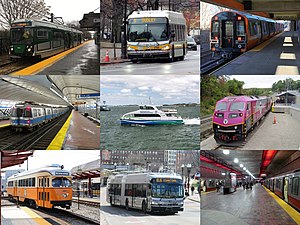
Back هيئة النقل بخليج ماساتشوستس Arabic Бостанскі мэтрапалітэн BE-X-OLD Massachusetts Bay Transportation Authority German Massachusetts Bay Transit Authority Finnish Massachusetts Bay Transportation Authority French Massachusetts Bay Transportation Authority ID マサチューセッツ湾交通局 Japanese ბოსტონის მეტროპოლიტენი Georgian 매사추세츠만 교통공사 Korean मॅसेच्युसेट्स बे ट्रान्सपोर्टेशन ऑथोरिटी Marathi
| Massachusetts Bay Transportation Authority | |
|---|---|
 | |
 | |
| Overview | |
| Locale | Greater Boston, Massachusetts, US |
| Transit type | |
| Daily ridership | 812,400 (weekdays, Q3 2024)[1] |
| Annual ridership | 239,981,700 (2023)[2] |
| Chief executive | Phillip Eng |
| Headquarters | 10 Park Plaza Boston, Massachusetts 02116 |
| Website | mbta |
| Operation | |
| Began operation | August 1964 (Predecessors date back to 1834) |
| Operator(s) |
|
The Massachusetts Bay Transportation Authority (abbreviated MBTA and known colloquially as "the T")[3][4] is the public agency responsible for operating most public transportation services in Greater Boston, Massachusetts. The MBTA transit network includes the MBTA subway with three metro lines (the Blue, Orange, and Red lines), two light rail lines (the Green and Mattapan lines), and a five-line bus rapid transit system (the Silver Line); MBTA bus local and express service; the twelve-line MBTA Commuter Rail system, and several ferry routes. In 2023, the system had a ridership of 239,981,700, or about 812,400 per weekday as of the third quarter of 2024, of which the rapid transit lines averaged 267,700 and the light rail lines 102,500, making it the fourth-busiest rapid transit system and the third-busiest light rail system in the United States. As of the third quarter of 2024, average weekday ridership of the commuter rail system was 109,300, making it the fifth-busiest commuter rail system in the U.S.
The MBTA is the successor of several previous public and private operators. Privately operated transit in Boston began with commuter rail in 1834 and horsecar lines in 1856. The various horsecar companies were consolidated under the West End Street Railway in the 1880s and electrified over the next decade. The Boston Elevated Railway (BERy) succeeded the West End in 1897; over the next several decades, the BERy built a partially-publicly owned rapid transit system, beginning with the Tremont Street subway in 1897. The BERy came under the control of public trustees in 1919, and was subsumed into the fully-publicly owned Metropolitan Transit Authority (MTA) in 1947. The MTA was in turn succeeded in 1964 by the MBTA, with an expanded funding district to fund declining suburban commuter rail service. In its first two decades, the MBTA took over the commuter rail system from the private operators and continued expansion of the rapid transit system. Originally established as an individual department within the Commonwealth of Massachusetts, the MBTA became a division of the Massachusetts Department of Transportation (MassDOT) in 2009.
- ^ "Transit Ridership Report Third Quarter 2024" (PDF). American Public Transportation Association. November 20, 2024. Retrieved November 23, 2024.
- ^ "Transit Ridership Report Fourth Quarter 2023" (PDF). American Public Transportation Association. March 4, 2024. Retrieved September 5, 2024.
- ^ Cite error: The named reference
Ferrywas invoked but never defined (see the help page). - ^ Cudahy, Brian J. (2003). A Century of Subways: Celebrating 100 Years of New York's Underground Railways. New York: Fordham University Press. p. 167. ISBN 9780823222957.